| Western blot (WB): | 1:500-2000 |
| Immunohistochemistry (IHC): | 1:50-400 |
| Immunocytochemistry/Immunofluorescence (ICC/IF): | 1:50-400 |
| Flow Cytometry (Fixed): | 1:50-200 |
| Enzyme linked immunosorbent assay (ELISA): | 1:100-1000 |
| (Boiling the paraffin sections in 10mM citrate buffer,pH6.0,or PH8.0 EDTA repair liquid for 20 mins is required for the staining of formalin/paraffin sections.) Optimal working dilutions must be determined by end user. | |
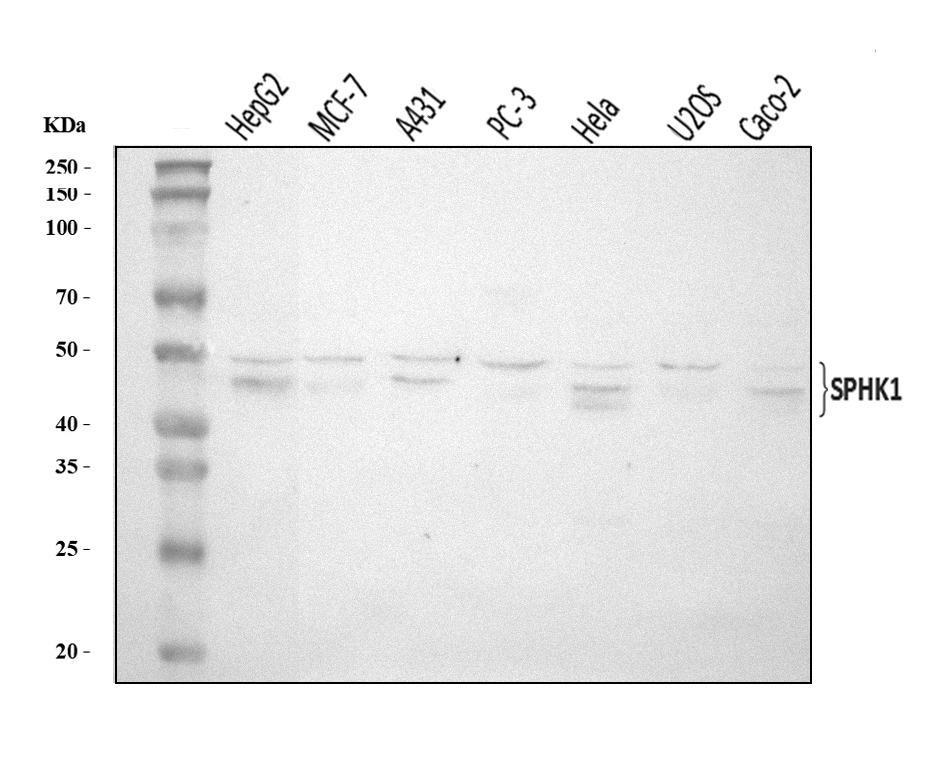
Western blot analysis of SPHK1 using anti-SPHK1 antibody (A01390-1). The sample well of each lane was loaded with 30 ug of sample under reducing conditions.
Lane 1: HepG2 whole cell lysates,
Lane 2: MCF-7 pc-12 whole cell lysates,
Lane 3: A431 whole cell lysates,
Lane 4: PC-3 whole cell lysates,
Lane 5: Hela whole cell lysates,
Lane 6: U2OS whole cell lysates,
Lane 7: Caco-2 whole cell lysates.
After electrophoresis, proteins were transferred to a membrane. Then the membrane was incubated with rabbit anti-SPHK1 antigen affinity purified polyclonal antibody (A01390-1) at a dilution of 1:1000 and probed with a goat anti-rabbit IgG-HRP secondary antibody (Catalog # BA1054). The signal is developed using ECL Plus Western Blotting Substrate (Catalog # AR1197). A specific band was detected for SPHK1 at approximately 45-50 kDa. The expected band size for SPHK1 is at 43 kDa.
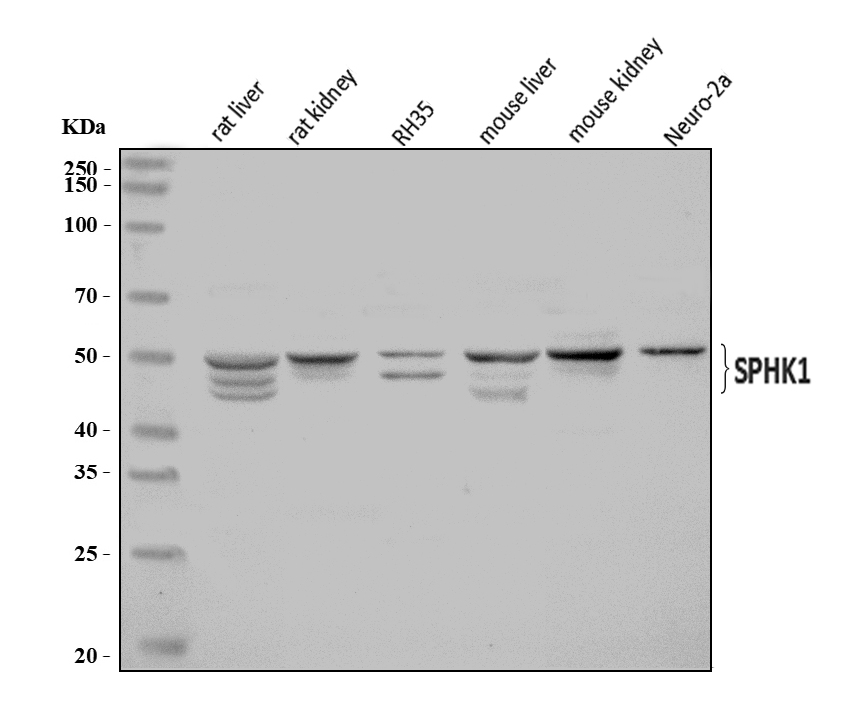
Western blot analysis of SPHK1 using anti-SPHK1 antibody (A01390-1). The sample well of each lane was loaded with 30 ug of sample under reducing conditions.
Lane 1: rat liver tissue lysates,
Lane 2: rat kidney tissue lysates,
Lane 3: RH35 whole cell lysates,
Lane 4: mouse liver tissue lysates,
Lane 5: mouse kidney tissue lysates,
Lane 6: Neuro-2a whole cell lysates.
After electrophoresis, proteins were transferred to a membrane. Then the membrane was incubated with rabbit anti-SPHK1 antigen affinity purified polyclonal antibody (A01390-1) at a dilution of 1:1000 and probed with a goat anti-rabbit IgG-HRP secondary antibody (Catalog # BA1054). The signal is developed using ECL Plus Western Blotting Substrate (Catalog # AR1197). A specific band was detected for SPHK1 at approximately 45-50 kDa. The expected band size for SPHK1 is at 43 kDa.
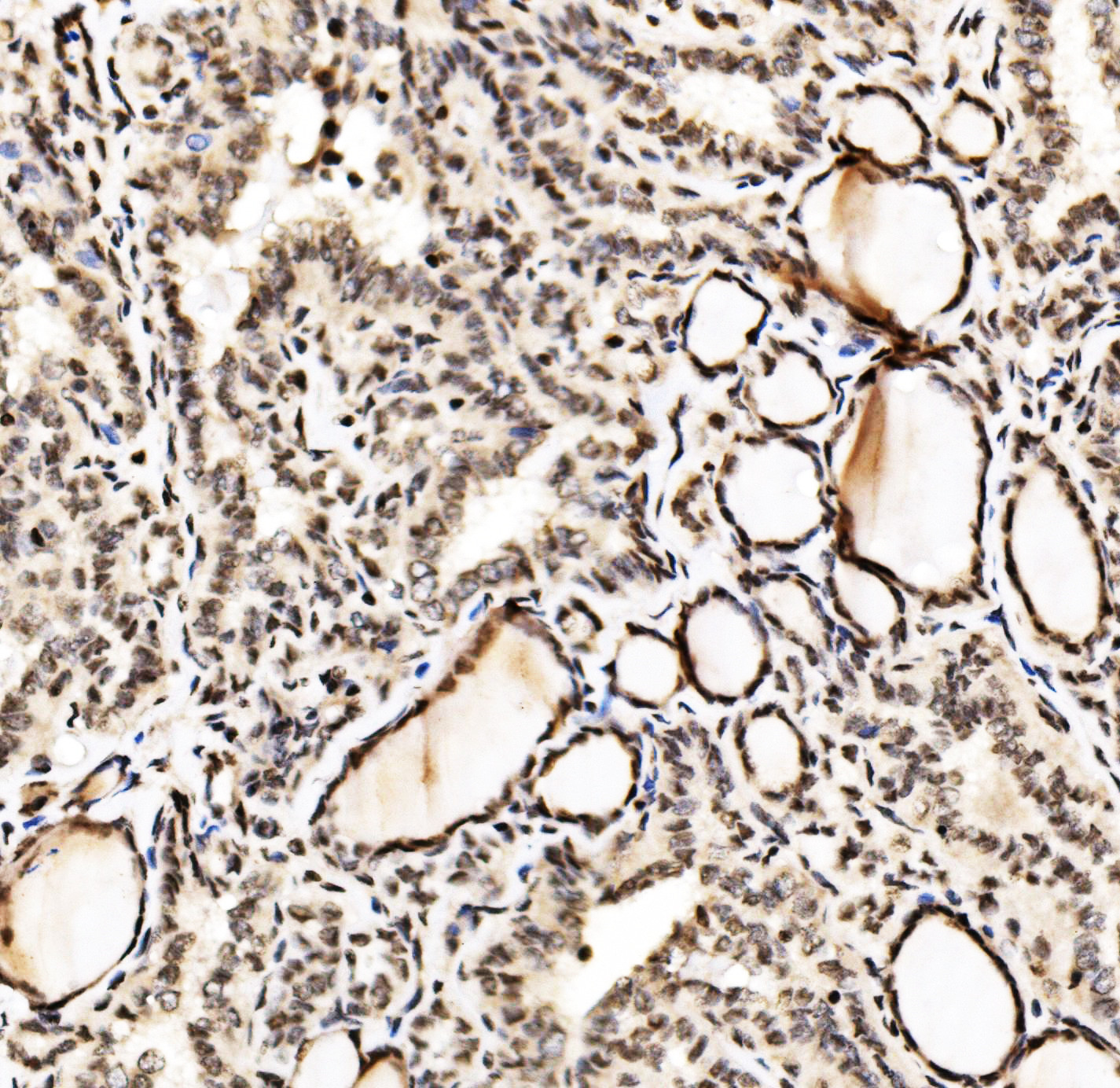
IHC analysis of SPHK1 using anti-SPHK1 antibody (A01390-1).
SPHK1 was detected in a paraffin-embedded section of human Hashintoto's thyroditis tissue. Biotinylated goat anti-rabbit IgG was used as secondary antibody. The tissue section was incubated with rabbit anti-SPHK1 Antibody (A01390-1) at a dilution of 1:200 and developed using Strepavidin-Biotin-Complex (SABC) (Catalog # SA1022) with DAB (Catalog # AR1027) as the chromogen.
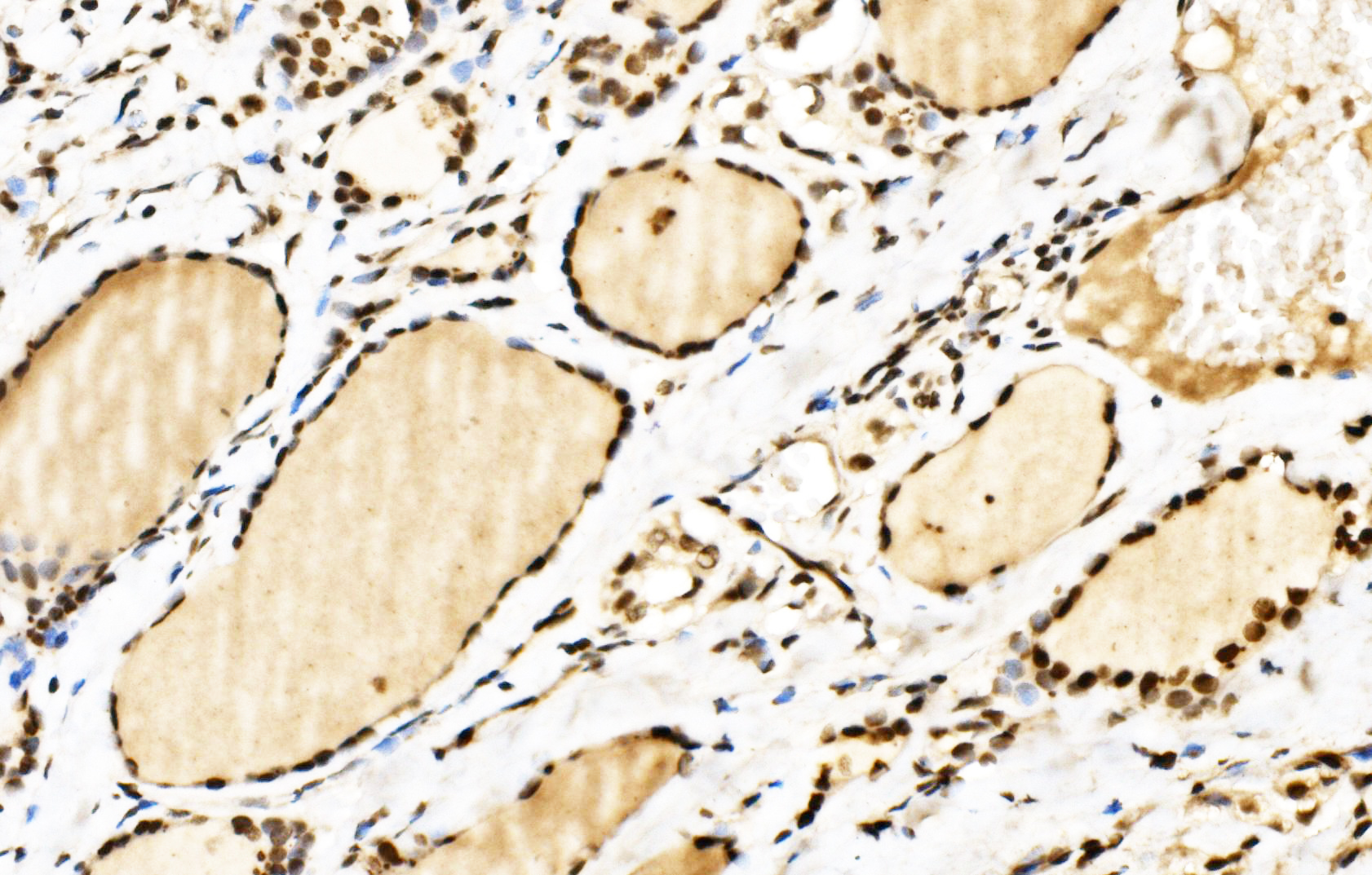
IHC analysis of SPHK1 using anti-SPHK1 antibody (A01390-1).
SPHK1 was detected in a paraffin-embedded section of human papillary thyroid carcinoma tissue. Biotinylated goat anti-rabbit IgG was used as secondary antibody. The tissue section was incubated with rabbit anti-SPHK1 Antibody (A01390-1) at a dilution of 1:200 and developed using Strepavidin-Biotin-Complex (SABC) (Catalog # SA1022) with DAB (Catalog # AR1027) as the chromogen.
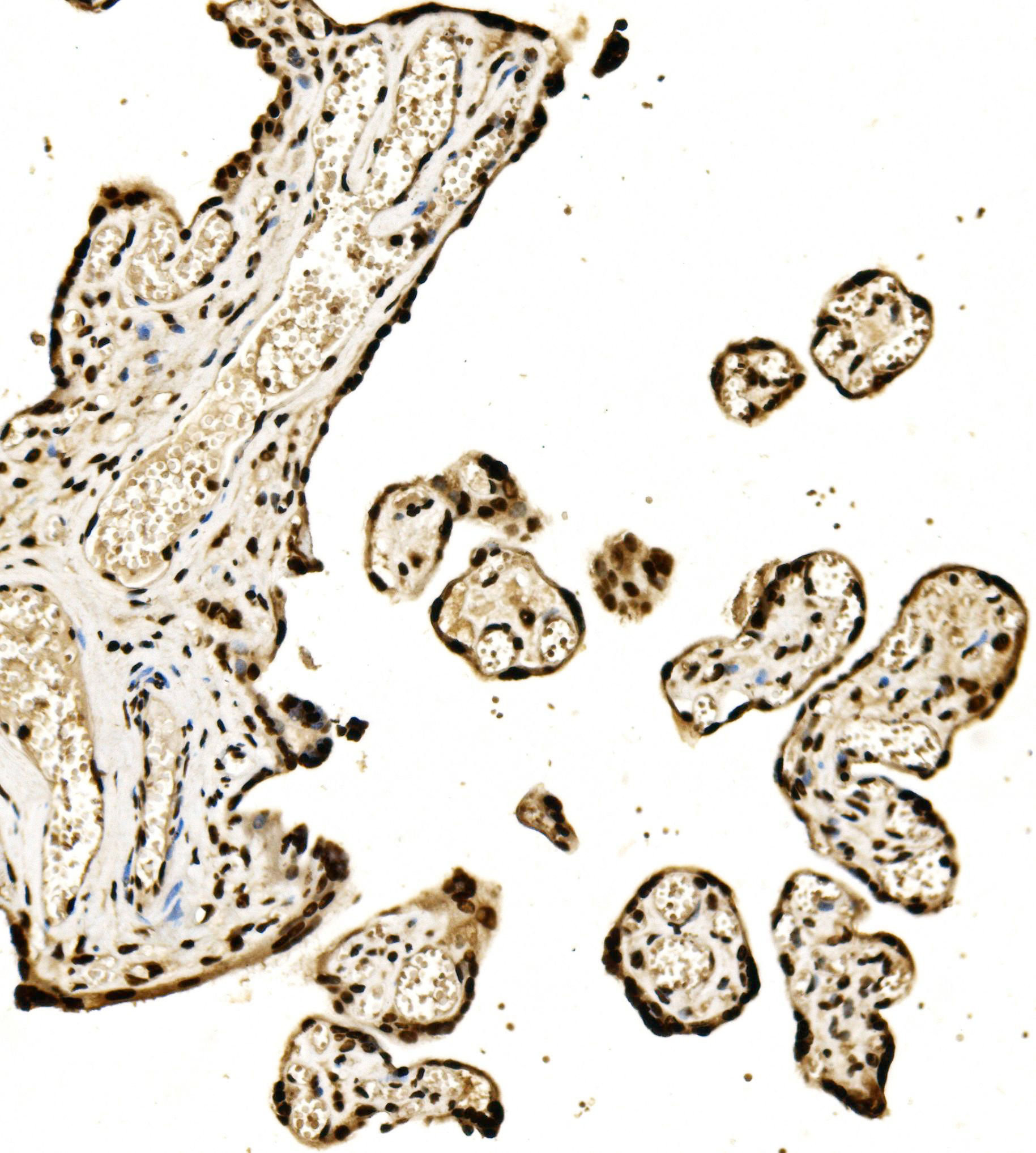
IHC analysis of SPHK1 using anti-SPHK1 antibody (A01390-1).
SPHK1 was detected in a paraffin-embedded section of human placenta tissue. Biotinylated goat anti-rabbit IgG was used as secondary antibody. The tissue section was incubated with rabbit anti-SPHK1 Antibody (A01390-1) at a dilution of 1:200 and developed using Strepavidin-Biotin-Complex (SABC) (Catalog # SA1022) with DAB (Catalog # AR1027) as the chromogen.
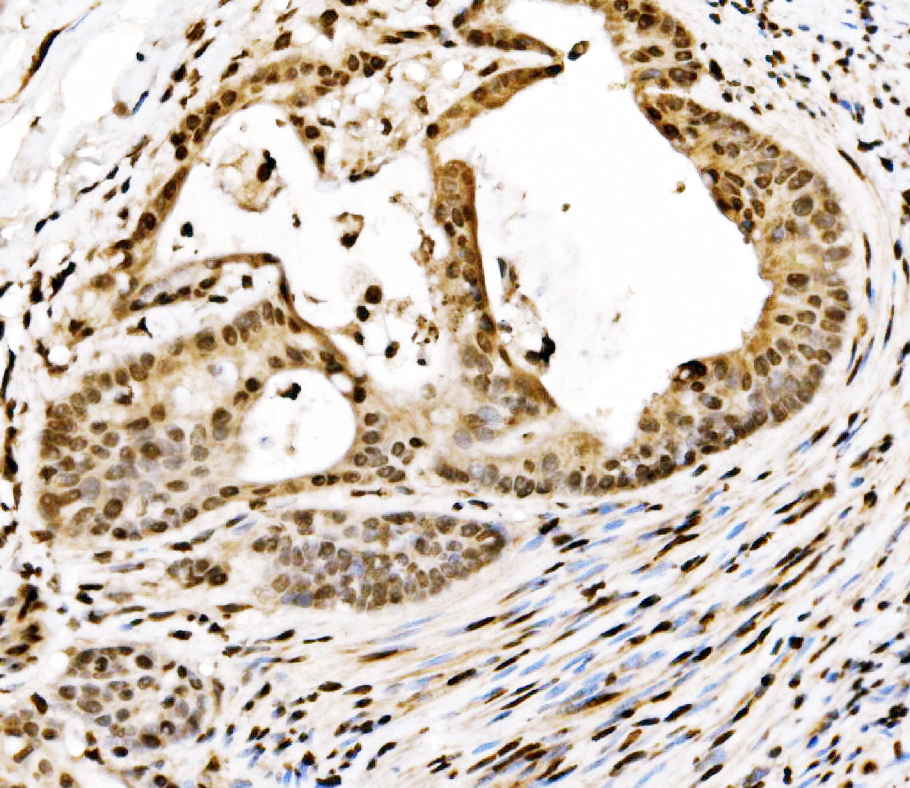
IHC analysis of SPHK1 using anti-SPHK1 antibody (A01390-1).
SPHK1 was detected in a paraffin-embedded section of human Gall bladder adenosquamous carcinoma tissue. Biotinylated goat anti-rabbit IgG was used as secondary antibody. The tissue section was incubated with rabbit anti-SPHK1 Antibody (A01390-1) at a dilution of 1:200 and developed using Strepavidin-Biotin-Complex (SABC) (Catalog # SA1022) with DAB (Catalog # AR1027) as the chromogen.
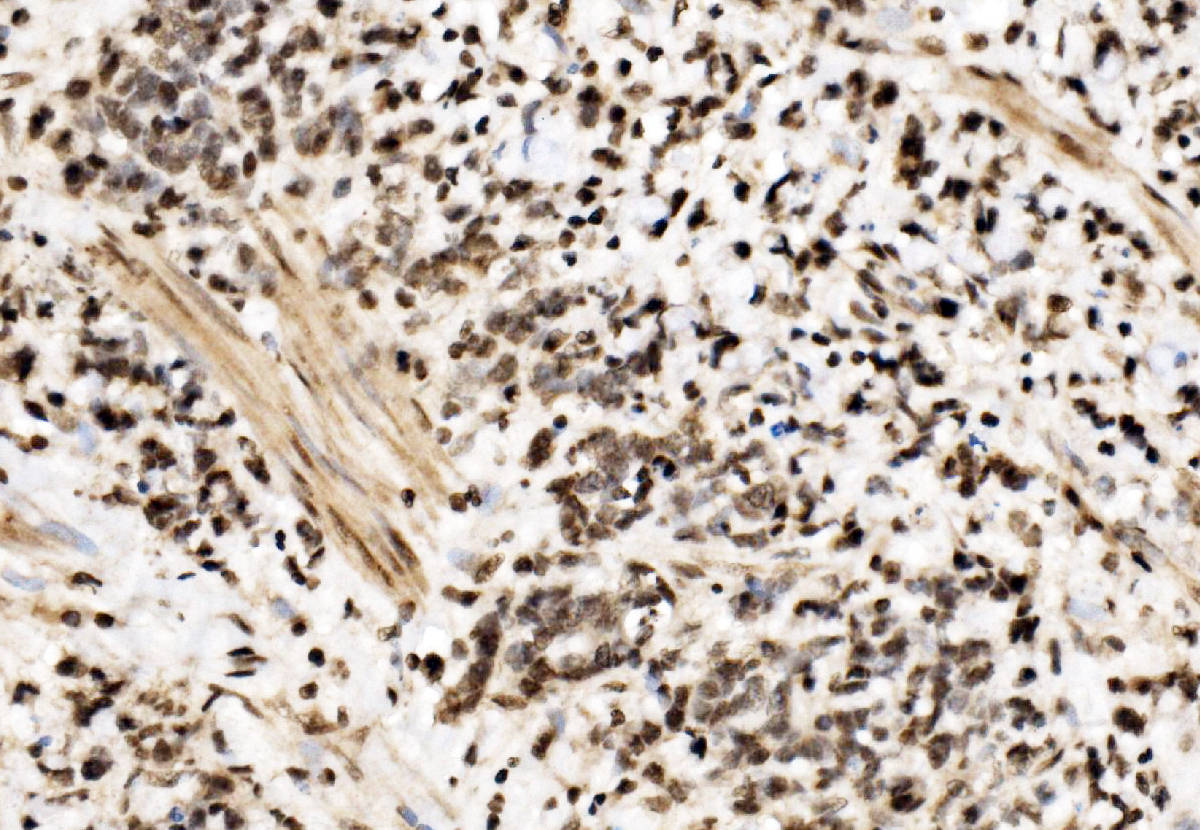
IHC analysis of SPHK1 using anti-SPHK1 antibody (A01390-1).
SPHK1 was detected in a paraffin-embedded section of human gastric cancer tissue. Biotinylated goat anti-rabbit IgG was used as secondary antibody. The tissue section was incubated with rabbit anti-SPHK1 Antibody (A01390-1) at a dilution of 1:200 and developed using Strepavidin-Biotin-Complex (SABC) (Catalog # SA1022) with DAB (Catalog # AR1027) as the chromogen.
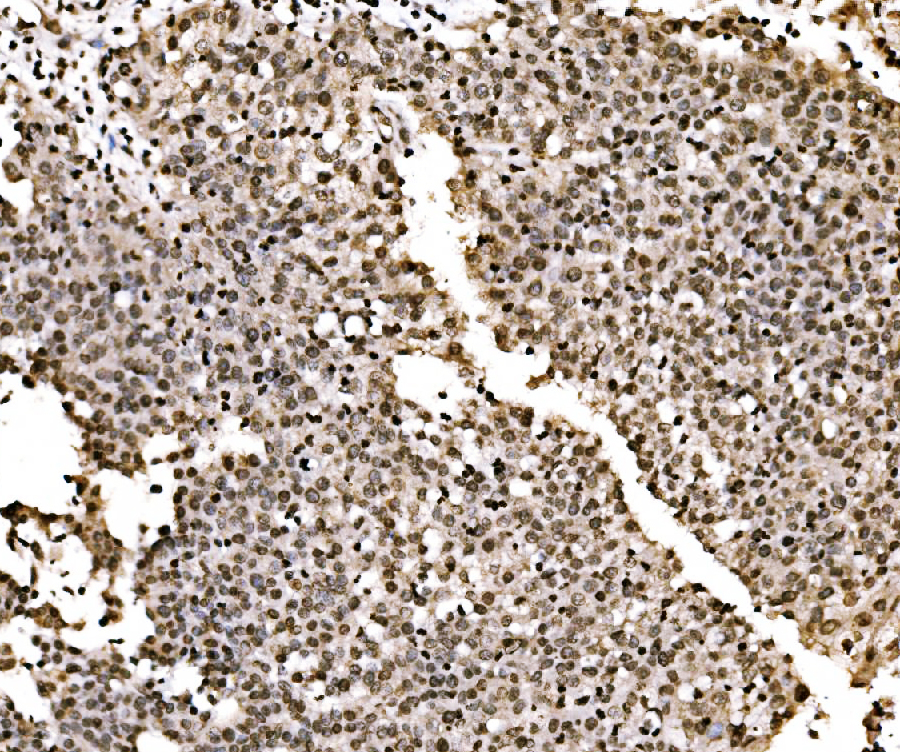
IHC analysis of SPHK1 using anti-SPHK1 antibody (A01390-1).
SPHK1 was detected in a paraffin-embedded section of human Laryngeal squamous cell carcinoma tissue. Biotinylated goat anti-rabbit IgG was used as secondary antibody. The tissue section was incubated with rabbit anti-SPHK1 Antibody (A01390-1) at a dilution of 1:200 and developed using Strepavidin-Biotin-Complex (SABC) (Catalog # SA1022) with DAB (Catalog # AR1027) as the chromogen.
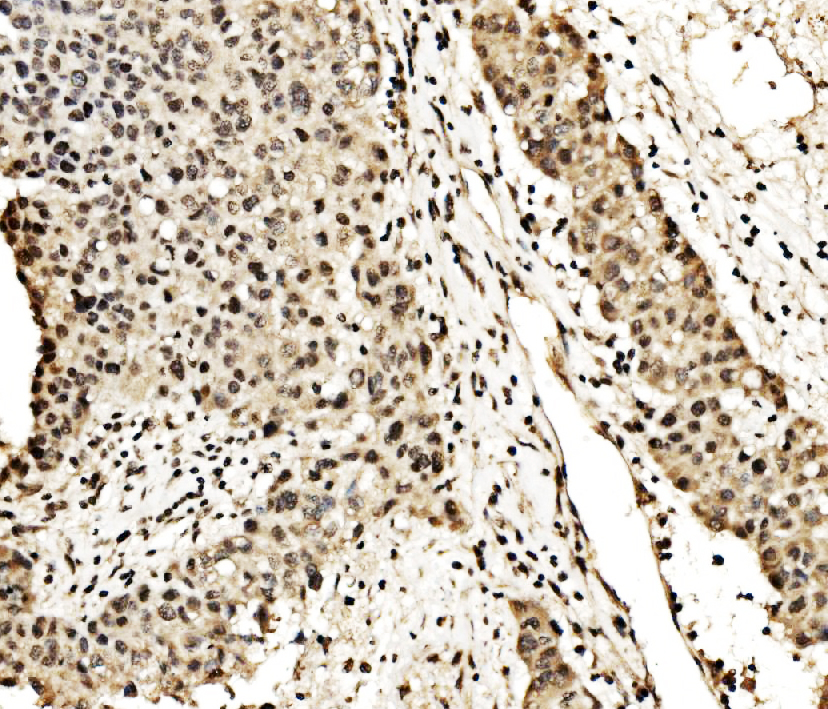
IHC analysis of SPHK1 using anti-SPHK1 antibody (A01390-1).
SPHK1 was detected in a paraffin-embedded section of human liver cancer tissue. Biotinylated goat anti-rabbit IgG was used as secondary antibody. The tissue section was incubated with rabbit anti-SPHK1 Antibody (A01390-1) at a dilution of 1:200 and developed using Strepavidin-Biotin-Complex (SABC) (Catalog # SA1022) with DAB (Catalog # AR1027) as the chromogen.
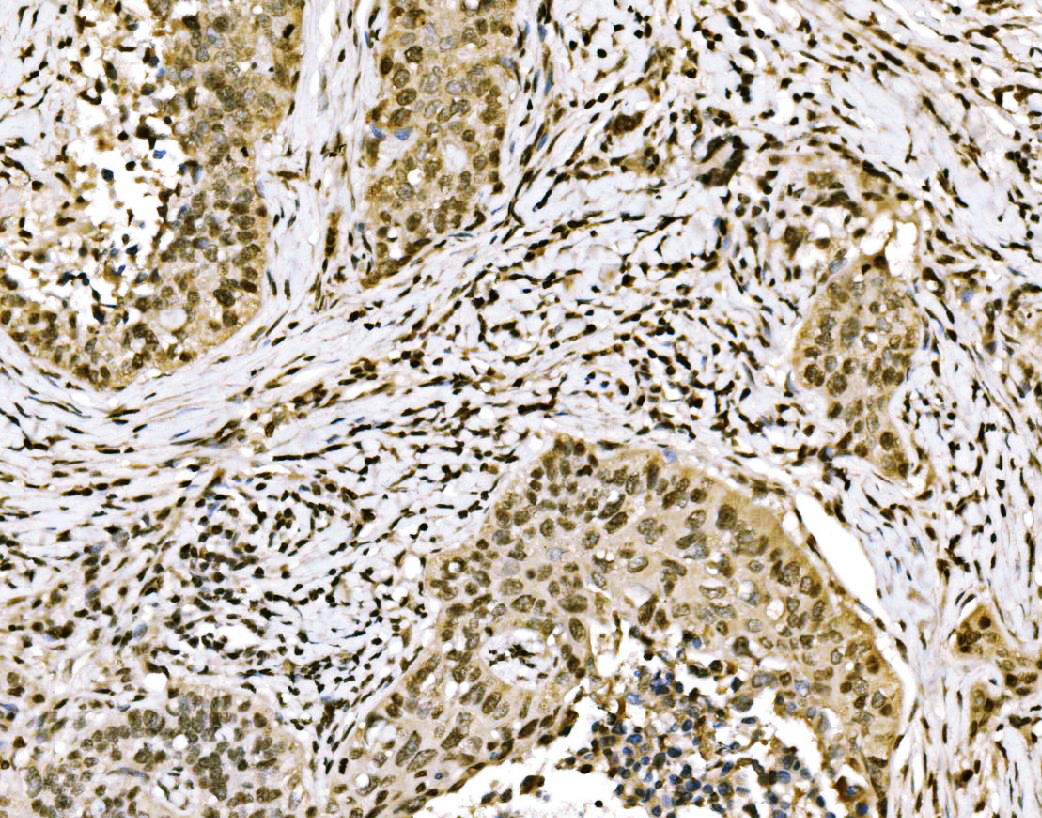
IHC analysis of SPHK1 using anti-SPHK1 antibody (A01390-1).
SPHK1 was detected in a paraffin-embedded section of human lung cancer tissue. Biotinylated goat anti-rabbit IgG was used as secondary antibody. The tissue section was incubated with rabbit anti-SPHK1 Antibody (A01390-1) at a dilution of 1:200 and developed using Strepavidin-Biotin-Complex (SABC) (Catalog # SA1022) with DAB (Catalog # AR1027) as the chromogen.
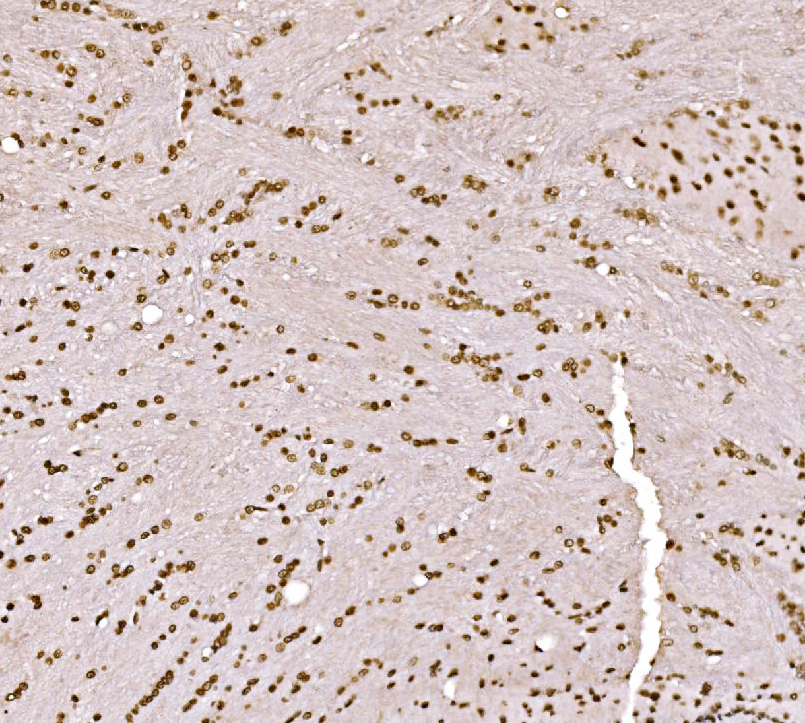
IHC analysis of SPHK1 using anti-SPHK1 antibody (A01390-1).
SPHK1 was detected in a paraffin-embedded section of rat brain tissue. Biotinylated goat anti-rabbit IgG was used as secondary antibody. The tissue section was incubated with rabbit anti-SPHK1 Antibody (A01390-1) at a dilution of 1:200 and developed using Strepavidin-Biotin-Complex (SABC) (Catalog # SA1022) with DAB (Catalog # AR1027) as the chromogen.
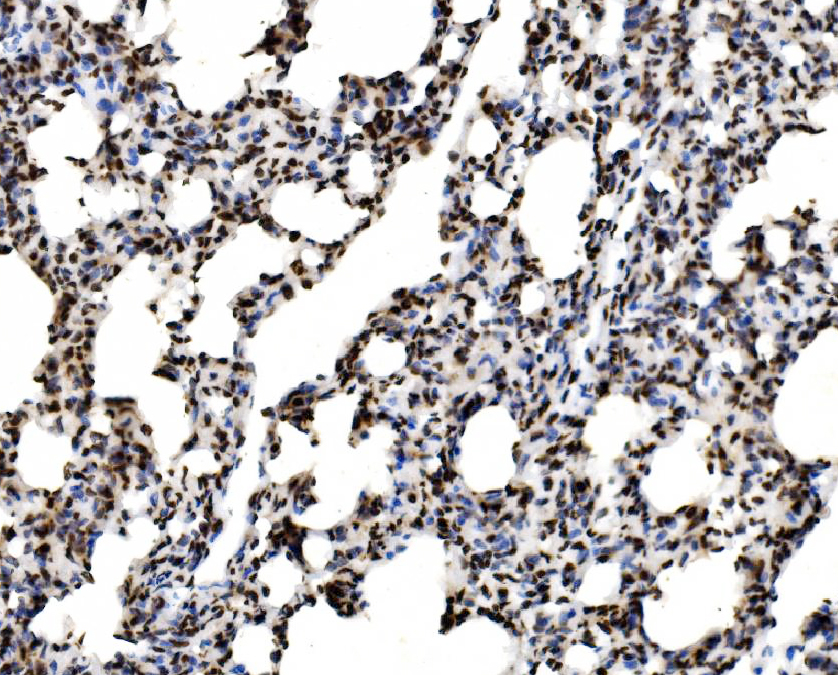
IHC analysis of SPHK1 using anti-SPHK1 antibody (A01390-1).
SPHK1 was detected in a paraffin-embedded section of rat lung tissue. Biotinylated goat anti-rabbit IgG was used as secondary antibody. The tissue section was incubated with rabbit anti-SPHK1 Antibody (A01390-1) at a dilution of 1:200 and developed using Strepavidin-Biotin-Complex (SABC) (Catalog # SA1022) with DAB (Catalog # AR1027) as the chromogen.
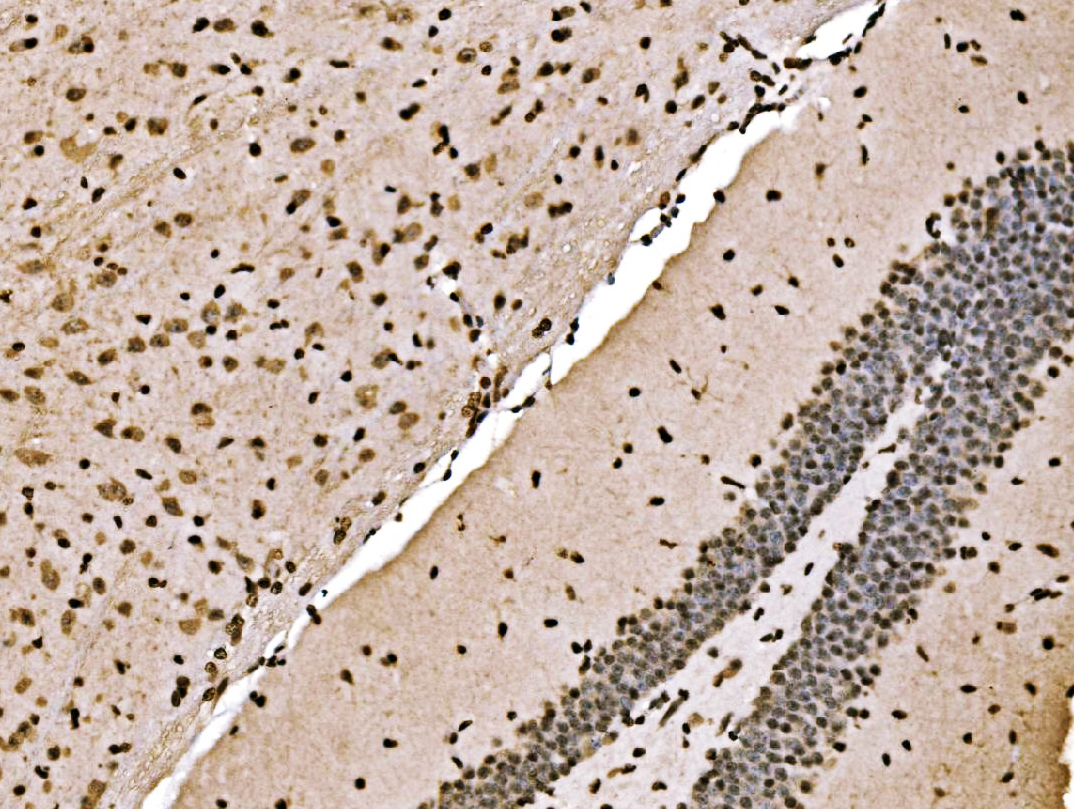
IHC analysis of SPHK1 using anti-SPHK1 antibody (A01390-1).
SPHK1 was detected in a paraffin-embedded section of mouse brain tissue. Biotinylated goat anti-rabbit IgG was used as secondary antibody. The tissue section was incubated with rabbit anti-SPHK1 Antibody (A01390-1) at a dilution of 1:200 and developed using Strepavidin-Biotin-Complex (SABC) (Catalog # SA1022) with DAB (Catalog # AR1027) as the chromogen.
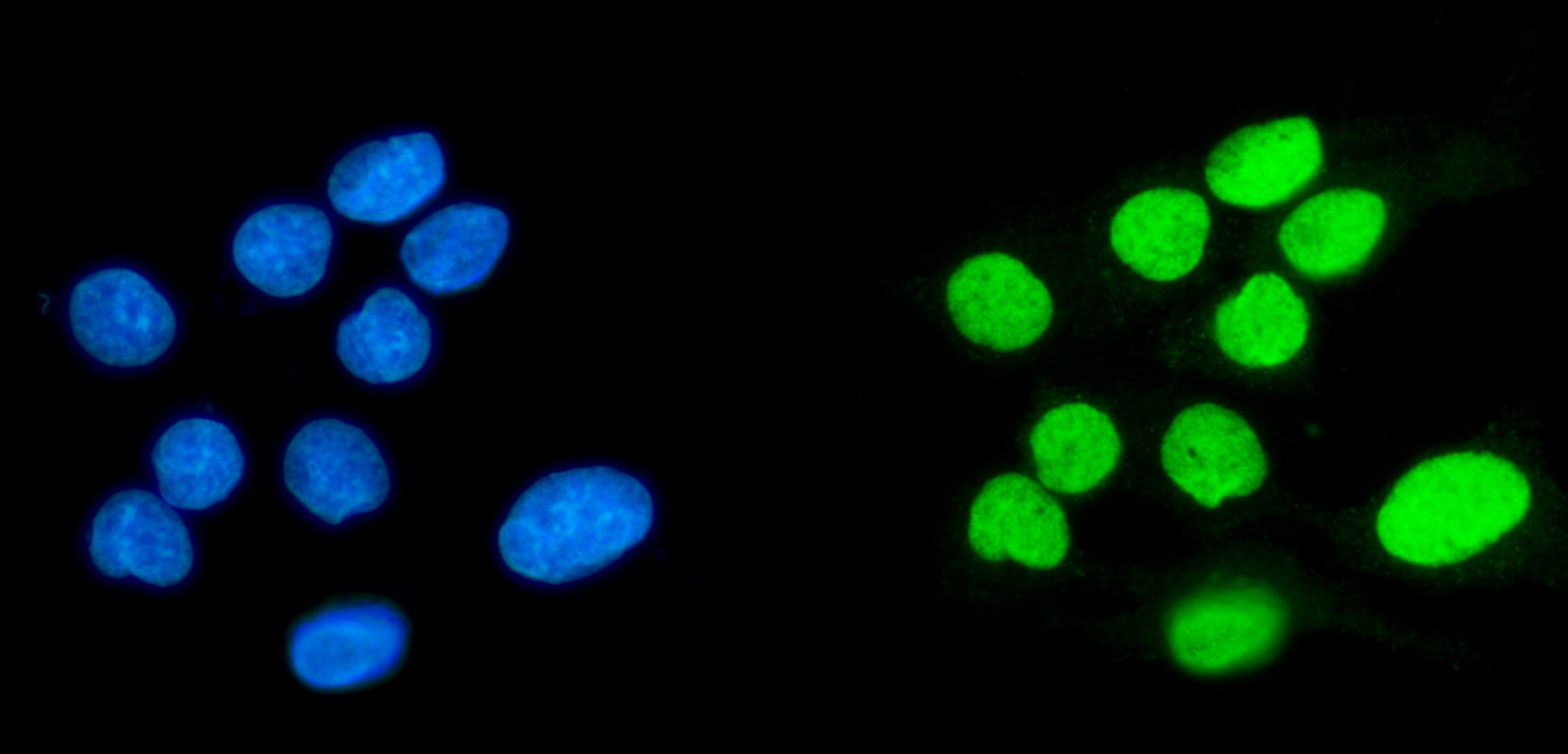
IF analysis of SPHK1 using anti-SPHK1 antibody (A01390-1).
SPHK1 was detected in an immunocytochemical section of HepG2 cells. The section was incubated with rabbit anti-SPHK1 Antibody (A01390-1) at a dilution of 1:100. DyLight®488 Conjugated Goat Anti-Rabbit IgG (Green) (Catalog # BA1127) was used as secondary antibody. The section was counterstained with DAPI (Catalog # AR1176) (Blue).
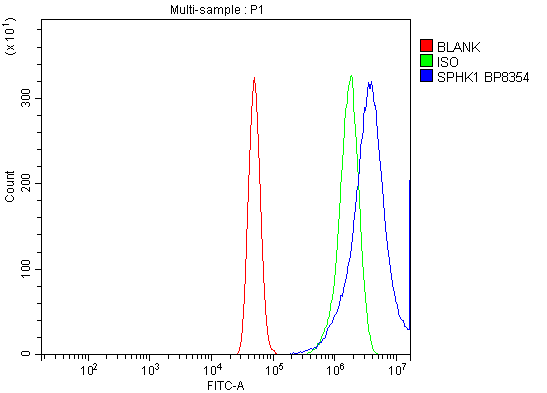
Flow Cytometry analysis of A431 cells using anti-SPHK1 antibody (A01390-1).
Overlay histogram showing A431 cells stained with A01390-1 (Blue line). To facilitate intracellular staining, cells were fixed with 4% paraformaldehyde and permeabilized with permeabilization buffer. The cells were blocked with 10% normal goat serum. And then incubated with rabbit anti-SPHK1 Antibody (A01390-1) at 1:100 dilution for 30 min at 20°C. DyLight®488 conjugated goat anti-rabbit IgG (BA1127) was used as secondary antibody at 1:100 dilution for 30 minutes at 20°C. Isotype control antibody (Green line) was rabbit IgG at 1:100 dilution used under the same conditions. Unlabelled sample without incubation with primary antibody and secondary antibody (Red line) was used as a blank control.

Western blot analysis of SPHK1 using anti-SPHK1 antibody (A01390-1). The sample well of each lane was loaded with 30 ug of sample under reducing conditions.
Lane 1: HepG2 whole cell lysates,
Lane 2: MCF-7 pc-12 whole cell lysates,
Lane 3: A431 whole cell lysates,
Lane 4: PC-3 whole cell lysates,
Lane 5: Hela whole cell lysates,
Lane 6: U2OS whole cell lysates,
Lane 7: Caco-2 whole cell lysates.
After electrophoresis, proteins were transferred to a membrane. Then the membrane was incubated with rabbit anti-SPHK1 antigen affinity purified polyclonal antibody (A01390-1) at a dilution of 1:1000 and probed with a goat anti-rabbit IgG-HRP secondary antibody (Catalog # BA1054). The signal is developed using ECL Plus Western Blotting Substrate (Catalog # AR1197). A specific band was detected for SPHK1 at approximately 45-50 kDa. The expected band size for SPHK1 is at 43 kDa.

Western blot analysis of SPHK1 using anti-SPHK1 antibody (A01390-1). The sample well of each lane was loaded with 30 ug of sample under reducing conditions.
Lane 1: rat liver tissue lysates,
Lane 2: rat kidney tissue lysates,
Lane 3: RH35 whole cell lysates,
Lane 4: mouse liver tissue lysates,
Lane 5: mouse kidney tissue lysates,
Lane 6: Neuro-2a whole cell lysates.
After electrophoresis, proteins were transferred to a membrane. Then the membrane was incubated with rabbit anti-SPHK1 antigen affinity purified polyclonal antibody (A01390-1) at a dilution of 1:1000 and probed with a goat anti-rabbit IgG-HRP secondary antibody (Catalog # BA1054). The signal is developed using ECL Plus Western Blotting Substrate (Catalog # AR1197). A specific band was detected for SPHK1 at approximately 45-50 kDa. The expected band size for SPHK1 is at 43 kDa.

IHC analysis of SPHK1 using anti-SPHK1 antibody (A01390-1).
SPHK1 was detected in a paraffin-embedded section of human Hashintoto's thyroditis tissue. Biotinylated goat anti-rabbit IgG was used as secondary antibody. The tissue section was incubated with rabbit anti-SPHK1 Antibody (A01390-1) at a dilution of 1:200 and developed using Strepavidin-Biotin-Complex (SABC) (Catalog # SA1022) with DAB (Catalog # AR1027) as the chromogen.

IHC analysis of SPHK1 using anti-SPHK1 antibody (A01390-1).
SPHK1 was detected in a paraffin-embedded section of human papillary thyroid carcinoma tissue. Biotinylated goat anti-rabbit IgG was used as secondary antibody. The tissue section was incubated with rabbit anti-SPHK1 Antibody (A01390-1) at a dilution of 1:200 and developed using Strepavidin-Biotin-Complex (SABC) (Catalog # SA1022) with DAB (Catalog # AR1027) as the chromogen.

IHC analysis of SPHK1 using anti-SPHK1 antibody (A01390-1).
SPHK1 was detected in a paraffin-embedded section of human placenta tissue. Biotinylated goat anti-rabbit IgG was used as secondary antibody. The tissue section was incubated with rabbit anti-SPHK1 Antibody (A01390-1) at a dilution of 1:200 and developed using Strepavidin-Biotin-Complex (SABC) (Catalog # SA1022) with DAB (Catalog # AR1027) as the chromogen.

IHC analysis of SPHK1 using anti-SPHK1 antibody (A01390-1).
SPHK1 was detected in a paraffin-embedded section of human Gall bladder adenosquamous carcinoma tissue. Biotinylated goat anti-rabbit IgG was used as secondary antibody. The tissue section was incubated with rabbit anti-SPHK1 Antibody (A01390-1) at a dilution of 1:200 and developed using Strepavidin-Biotin-Complex (SABC) (Catalog # SA1022) with DAB (Catalog # AR1027) as the chromogen.

IHC analysis of SPHK1 using anti-SPHK1 antibody (A01390-1).
SPHK1 was detected in a paraffin-embedded section of human gastric cancer tissue. Biotinylated goat anti-rabbit IgG was used as secondary antibody. The tissue section was incubated with rabbit anti-SPHK1 Antibody (A01390-1) at a dilution of 1:200 and developed using Strepavidin-Biotin-Complex (SABC) (Catalog # SA1022) with DAB (Catalog # AR1027) as the chromogen.

IHC analysis of SPHK1 using anti-SPHK1 antibody (A01390-1).
SPHK1 was detected in a paraffin-embedded section of human Laryngeal squamous cell carcinoma tissue. Biotinylated goat anti-rabbit IgG was used as secondary antibody. The tissue section was incubated with rabbit anti-SPHK1 Antibody (A01390-1) at a dilution of 1:200 and developed using Strepavidin-Biotin-Complex (SABC) (Catalog # SA1022) with DAB (Catalog # AR1027) as the chromogen.

IHC analysis of SPHK1 using anti-SPHK1 antibody (A01390-1).
SPHK1 was detected in a paraffin-embedded section of human liver cancer tissue. Biotinylated goat anti-rabbit IgG was used as secondary antibody. The tissue section was incubated with rabbit anti-SPHK1 Antibody (A01390-1) at a dilution of 1:200 and developed using Strepavidin-Biotin-Complex (SABC) (Catalog # SA1022) with DAB (Catalog # AR1027) as the chromogen.

IHC analysis of SPHK1 using anti-SPHK1 antibody (A01390-1).
SPHK1 was detected in a paraffin-embedded section of human lung cancer tissue. Biotinylated goat anti-rabbit IgG was used as secondary antibody. The tissue section was incubated with rabbit anti-SPHK1 Antibody (A01390-1) at a dilution of 1:200 and developed using Strepavidin-Biotin-Complex (SABC) (Catalog # SA1022) with DAB (Catalog # AR1027) as the chromogen.

IHC analysis of SPHK1 using anti-SPHK1 antibody (A01390-1).
SPHK1 was detected in a paraffin-embedded section of rat brain tissue. Biotinylated goat anti-rabbit IgG was used as secondary antibody. The tissue section was incubated with rabbit anti-SPHK1 Antibody (A01390-1) at a dilution of 1:200 and developed using Strepavidin-Biotin-Complex (SABC) (Catalog # SA1022) with DAB (Catalog # AR1027) as the chromogen.

IHC analysis of SPHK1 using anti-SPHK1 antibody (A01390-1).
SPHK1 was detected in a paraffin-embedded section of rat lung tissue. Biotinylated goat anti-rabbit IgG was used as secondary antibody. The tissue section was incubated with rabbit anti-SPHK1 Antibody (A01390-1) at a dilution of 1:200 and developed using Strepavidin-Biotin-Complex (SABC) (Catalog # SA1022) with DAB (Catalog # AR1027) as the chromogen.

IHC analysis of SPHK1 using anti-SPHK1 antibody (A01390-1).
SPHK1 was detected in a paraffin-embedded section of mouse brain tissue. Biotinylated goat anti-rabbit IgG was used as secondary antibody. The tissue section was incubated with rabbit anti-SPHK1 Antibody (A01390-1) at a dilution of 1:200 and developed using Strepavidin-Biotin-Complex (SABC) (Catalog # SA1022) with DAB (Catalog # AR1027) as the chromogen.

IF analysis of SPHK1 using anti-SPHK1 antibody (A01390-1).
SPHK1 was detected in an immunocytochemical section of HepG2 cells. The section was incubated with rabbit anti-SPHK1 Antibody (A01390-1) at a dilution of 1:100. DyLight®488 Conjugated Goat Anti-Rabbit IgG (Green) (Catalog # BA1127) was used as secondary antibody. The section was counterstained with DAPI (Catalog # AR1176) (Blue).

Flow Cytometry analysis of A431 cells using anti-SPHK1 antibody (A01390-1).
Overlay histogram showing A431 cells stained with A01390-1 (Blue line). To facilitate intracellular staining, cells were fixed with 4% paraformaldehyde and permeabilized with permeabilization buffer. The cells were blocked with 10% normal goat serum. And then incubated with rabbit anti-SPHK1 Antibody (A01390-1) at 1:100 dilution for 30 min at 20°C. DyLight®488 conjugated goat anti-rabbit IgG (BA1127) was used as secondary antibody at 1:100 dilution for 30 minutes at 20°C. Isotype control antibody (Green line) was rabbit IgG at 1:100 dilution used under the same conditions. Unlabelled sample without incubation with primary antibody and secondary antibody (Red line) was used as a blank control.
















